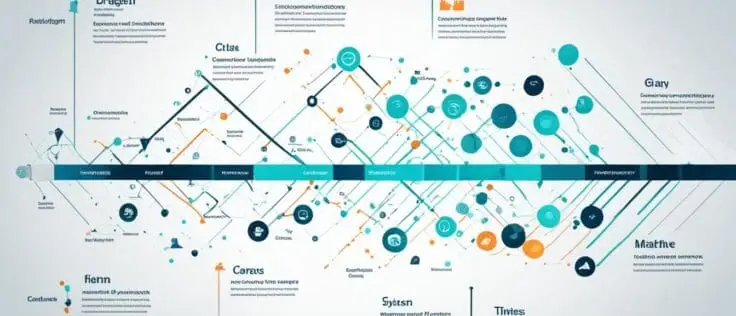In an industry propelled by rapid innovation and fierce competition, predictive modelling in marketing stands at the forefront, heralding a new era of strategic proficiency. Delving deep into market trends and behavioural data, this cutting-edge approach not only predicts likely campaign outcomes with impressive accuracy but also empowers businesses to operate on the vanguard of data-driven strategies. By embracing the predictive prowess offered by complex algorithms and vast datasets, market leaders are now able to make informed decision-making the cornerstone of every campaign, ensuring that every marketing effort is both tactical and anticipatory.
Whether it’s anticipating the ebb and flow of consumer desires or calculating the impact of future campaigns, predictive modelling equips savvy marketers with a blueprint for success. Such an approach cements the transition from hindsight to foresight, allowing firms to translate the empirical wisdom of past behaviour into actionable strategies for tomorrow. As a bastion of innovation in the United Kingdom’s vibrant market, predictive modelling is transforming the landscape of commerce with every calculated prediction and strategic move forward.
Demystifying Predictive Modelling in Marketing
At the heart of modern marketing strategies, predictive modelling stands as a transformative force, guiding marketing decision-makers through the intricate maze of consumer data and digital interactions. By analysing current and historical datasets, this potent statistical approach enables the formulation of predictions that illuminate the path to consumer engagement with a startling degree of precision. With its arsenal of sophisticated algorithms and machine learning capabilities, predictive modelling morphs vast amounts of raw data into actionable insights, charting a course for dynamic and responsive marketing tactics.
Delving into the myriad of available statistical models, marketers can select from decision trees, regression models, and neural networks, each tailored to specific prediction outcomes and types of data. Such targeted utilisation propels the strategic calibration of marketing activities, sharpening the focus on customer engagement and individualised experiences. These models stand as beacons, providing clarity on which customers are most likely to churn and thus inform proactive retention strategies, or which segments to approach for the maximum amplification of campaign effectiveness.
Fusing the predictive prowess of these models with forward-thinking execution, businesses are not merely reacting to market impulses but actively shaping the trajectory of consumer interactions. This unprecedented grip on the rudder of commerce is significantly elevating the capabilities of marketers, as they fine-tune their strategies to not just sail with the current market winds, but to harness them, propelling towards enhanced engagement and deepened consumer rapport.
In essence, predictive modelling in marketing deftly bridges the gap between data and decision, transforming uncertainty into a strategic asset. It is here that the potency of this statistical soothsaying is most palpable, providing a clear vision for marketing endeavours that is both informed and innovative, ensuring that businesses across the United Kingdom are strategically aligned with the ever-evolving tapestry of consumer desire.
Emerging Trends in Predictive Modelling
The realm of marketing is witnessing a paradigm shift, with predictive analytics in ecommerce leading the charge towards realising a more anticipatory and personalized engagement with consumers. As businesses seek to refine their strategic compass, the ability to conduct target audience prediction is becoming invaluable. Through scrutinizing patterns within historical purchase data and online behavioural footprints, brands gain insights that fuel the crafting of highly personalised narratives tailored to consumer predilections.
This burgeoning trend extends beyond mere customer acquiescence, maturing into sophisticated consumer behaviour forecasting. Marketers now deftly manoeuvre through the tapestry of consumer interactions to not only respond to current trends but to also shape future ones. By modelling and anticipating these behaviours, marketing professionals are empowered to create more coherent and resonant marketing strategies that cater to the unspoken needs of their audience.
In a similar vein, market trend prediction stands as a formidable ally in a marketer’s toolkit, arming them with the foresight to pivot and adapt to emerging trends. Whether it’s the burgeoning preference for eco-conscious products or the adoption of pioneering digital channels, predictive modelling offers a strategic vantage point from which to proactively embrace these shifts, keeping businesses at the competitive forefront.
Furthermore, the implementation of sentiment analysis harnesses the vast and often untamed expanse of consumer feedback and online dialogue. Accuracy in gauging public opinion and sentiment provides an additional strategic layer, offering an intrinsic view of the market’s pulse. With such enriched data at their disposal, marketing virtuosos can refine their strategies, ensuring resonance with their target audience’s evolving preferences and opinions.
In conclusion, as predictive modelling continues to surface as a cornerstone of contemporary marketing strategies, businesses in the United Kingdom remain steadfast in their commitment to embrace the evolving trends. By charting the trajectory of consumer behaviour and market nuances, marketers lay the groundwork for responsive and insightful engagement—ultimately sculpting a future aligned with anticipation and strategic innovation.
The Data-Driven Approach: Customer Segmentation and Behavioural Forecasting
In the quest for marketing excellence within the United Kingdom, the data-driven approach has redefined the art of customer interaction. Through meticulous data analysis in digital marketing, businesses are now harnessing the power of predictive modelling to forge deeper connections with their audience. At the crux of this approach lies customer segmentation, a process that transcends traditional demographics and delves into the nuanced realms of consumer behaviour and preferences.

Predictive modelling thrives on its ability to segment customers not merely by the superficial, but by their actions and potential. Be it transaction data or digital footprints, every customer interaction feeds into the models, providing insights that fuel personalised marketing strategies. With such granularity, marketing efforts become not just targeted, but almost predestined to resonate with the recipients.
An integral part of this strategy is behavioural forecasting in sales, where predictive patterns help anticipate customer actions, allowing for a kind of pre-emptive fulfilment of their needs and desires. This foresight becomes particularly potent when coupled with predictive scoring, where each customer’s potential value and likelihood to convert are quantified, distinguishing ripe prospects from those who require a more nurturing approach.
Moreover, this refined approach to segmentation and forecasting is a linchpin in crafting a seamless omnichannel experience. Marketers, armed with predictive insights, can now orchestrate marketing symphonies across multiple channels, each note striking when and where the customer is most receptive. By anticipating the preferred channels and content for customers, businesses are setting the stage for a marketing campaign that does more than engage—it captivates.
Ultimately, the data-driven approach marries the predictive capabilities of advanced modelling with the human touch of bespoke experiences. In doing so, it is not just predicting the future—it is shaping a future where every marketing interaction is an echo of the customer’s own preferences and behaviours, a mirror reflecting their individuality back at them with uncanny accuracy.
Unlocking the Potential of Machine Learning in Advertising
Within the ambitious landscape of UK marketing, machine learning in advertising emerges as a linchpin for the several facets of progressive campaigns. Renowned brands and upstarts alike are leveraging these advanced technologies to craft personalized marketing messages that resonate on a deeper, more individual level with consumers, showcasing a synergy that exemplifies the power and potential of a technical-human interface in contemporary commerce.
To navigate the complexities of consumer behaviour, tools such as SAS Advanced Analytics and IBM Predictive Analytics are being deployed to construct models that articulate with uncanny precision. These models encapsulate vast arrays of consumer interactions, enabling the distillation of predictive insights that become the bedrock of responsive and proactive engagement strategies.
Other platforms in the fray, including Tableau and RapidMiner, further democratize predictive modelling with their intuitive user interfaces. They offer a dual benefit: simplification of the complex analytics process and empowerment of marketers, who can now become the architects of potent predictive models without a deep background in data science. This accessibility facilitates a marketing automation revolution, optimising the choreography of campaigns and customer interactions with impressive dexterity.
The agility of these platforms is not confined to insights delivery; they are key players in enacting a real-time responsiveness. The dynamic nature of marketing automation technologies enables campaigns to pivot and adapt with a fluidity that mirrors the volatile patterns of consumer behaviour. The goal is not to create static strategies but to foster a landscape characterised by its robustness and adaptability, ensuring that marketing messages remain relevant in the face of changing market conditions.
Succinctly, machine learning in advertising is the proverbial ‘open sesame’ to a treasure trove of marketing potential. Personalised experiences can now be orchestrated on an unprecedented scale, as brands fine-tune their interactions based on the rich, data-driven insights at their disposal. This alchemy of data and strategy amalgamates to form the centrepiece of robust marketing strategies, setting the stage for engagement and communication that are not just visible but vitally vivacious in their appeal and effectiveness.
Predictive Modelling in Marketing
At the zenith of technological innovation, predictive modelling in marketing has crystallised as the nucleus of navigating customer preferences and shaping future commercial landscapes. This paradigm shift from a reactive approach to a pre-emptive, data-savvy analysis characterises the contemporary marketing era, predominating every corner of the United Kingdom’s dynamic markets.
In the bustling world of e-commerce, predictive analytics emerges as a cardinal tool, deciphering data to forecast consumer purchasing patterns. Marketers are no longer mere spectators but influential forecasters, wielding granular customer segmentation and behavioural forecasting in sales to preemptively align with consumer inclinations.
Marketing automation, a vital component of this new era, empowers brands with a unique finesse – the seamless orchestration of campaigns based on predicted behavioural cascades. Such automation not only augments efficiency but also amplifies the accuracy of engaging targeted clienteles, heralding a future where marketing is both an art and a precise science.
Through the lens of predictive analytics in e-commerce, brands extrapolate vast data sets to attain a holistic understanding of their customers. This extends to a meticulous foresight about the target audience prediction, where brands articulate strategies tailored to meet the evolving demands of the market.
With its clairvoyant capabilities, predictive modelling affords businesses a radical edge, enabling robust growth strategies that identify nascent demand spikes and untapped market segments. Marketers adept at charting such prescient courses ensure that their organisations are not just thriving but are poignantly resonating with consumers’ future needs.
The narrative of marketing is thus rewritten, no longer based on historical data alone but transformed through the predictive prowess that anticipates the zeitgeist of consumer behavior. These insights propel businesses into the vanguard of the marketplace, orchestrating campaigns that resonate with precision and proactive brilliance.
As the narrative of commerce swiftly progresses, enterprises across – from SME’s to global giants – are increasingly integrating predictive and behavioural forecasting into their market strategies. The concerted use of these advanced analytics and machine learning techniques ensures that marketing efforts are not just seen but felt, marking a transformative chapter in the chronicles of marketing within the United Kingdom and beyond.
Conclusion
In the bustling landscape of the United Kingdom’s digital market, predictive modelling in marketing has emerged as a formidable force, redefining traditional approaches to commercial engagement. It signifies a strategic revolution, enabling enterprises to not just navigate but to craft the future market currents with acumen. By critically analysing historical data, employing sophisticated analytics, and applying machine learning techniques, brands gain a distinct competitive advantage as they finetune their marketing sails to the winds of consumer demand.
This innovative approach to marketing transcends the mere act of advertising, evolving into a dynamic conversation with the market itself, informed by informed by customer insight and propelled by data-driven marketing. Fusing the empirical with the predictive, marketers can now anticipate consumer needs with heightened precision, fostering stronger connections and encouraging steadfast loyalty. Strategic marketing decisions are no longer gambles in the game of chance but calculated manoeuvres on the chessboard of commerce, each more confident and informed than the last.
As the UK’s businesses peer into the marketing horizons, the integration of predictive modelling into their strategic frameworks becomes not merely an option but an imperative for sustained success and innovation. The future of marketing is unmistakably tied to the predictive engines that now power it, promising a realm where engagement, conversion, and customer experience are continually enhanced. It represents a critical pivot point for businesses aiming for the forefront of their industries, a journey marked by continual learning and adaptation — an essential trek to secure a lasting legacy in an ever-competitive marketplace.






